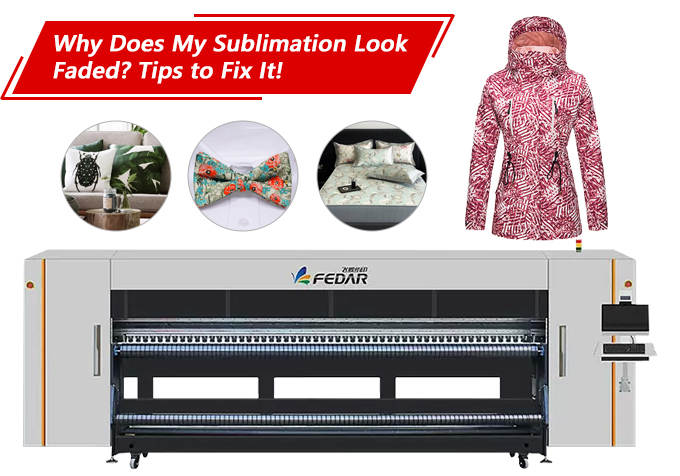30
Jul
When it comes to sublimation printing, many different issues can arise! It can be irksome. If you are one of those, thinking, "why does my sublimation look faded?" you're not alone. In reality, it's far more common than you may think. But don't worry, we'll take care of the situation for you.
This article will walk you through everything you need to know, like why your designs look or feel shady and not-so-bright, how to fix them, and what materials you can use sublimation on. By the end, you'll "sublimate" like a pro without any kind of roadblocks.
Printing on the wrong paper or using a so-called budget sublimation printer can result in dull or faded prints, but there are also a handful of other reasons that could be at play. Let's look at them one by one:
The entire sublimation process is dependent on the quality of your tools. Using poor-quality ink makes your print fade away quickly, as it won't be properly coated. In the same way, sublimation paper of low quality can lead to dull, inaccurate prints, as it may not release ink effectively.
Heat and pressure are the "spine" of sublimation. But even a slight imbalance in these elements can cause your prints to fade. If the heat setting is too lofty or low, or if the pressure isn't evenly distributed, it can result in dull or washed-out colors. The print also loses its original shape and texture.
Another most frequent reason for fading is being exposed to light and moisture. No matter how good your printer, ink, and paper are, if your prints are not properly stored or displayed, they can lose their vibrant colors over time. Ultraviolet light and humidity can damage the ink molecules and cause them to fade.
Sublimation printing works best on 100% polyester or specially coated materials. If you use the wrong ones, like cotton, the ink molecules cannot fully sublimate. The result:
Poor quality prints
Faded colors and low vibrancy
Crackling or peeling of design
Loss of details
Other possible common factors include inconsistent time, inappropriate setting, and washing in hot water. In short, any carelessness in the sublimation process can lead to dull and faded results.
While, initially, it may seem like a lot of "don't" and "be careful," the solution to sublimation printing fade is much easier. With a little caution and a few trial & error sessions, you can get back your vibrant prints.
Here's what you can do:
The first thing you can do? Pick good-quality tools. A sublimation printer is like the heart of the process, and a good one can save you from so many problems. The same thing applies to ink and paper. Always go for the superb quality you can afford.
Without optimized settings, it's not possible to achieve what you're aiming for. It's essential to maintain the proper heat and pressure to get the expected results. Aside from that, you should:
Shut down fast printing modes
Pick the best print quality
Install ICC profiles
Configure the driver for the correct paper
Daily update firmware and software
Keep ink cartridges filled
As we said earlier, light and moisture can damage your prints. So be extra careful when handling them. Keep them away from direct sunlight to avoid UV exposure. When not in use, cover them with clean paper or store them in a tightly closed box or bag to keep out humidity.
Besides these points, you should also check other steps too. For example, don't move the substrate while printing, wash it at low temp, and set the right timings. A little carefulness can go a long way in getting bright, vibrant prints.
Is everything sublimatable? Well, no. Not every material works well for sublimation printing. In fact, some don't work at all. Here's a quick rundown of what you can sublimate on:
100% Polyester: It is by far one of the best materials used for sublimation. It absorbs ink on an atomic level and produces vibrant, long-lasting prints. A blend of 65% polyester with 35% cotton could also work.
Sublimation Blank Products: Anything coated with polyester can be sublimated. These include hardboard, mugs, metal, plastic, wood, etc.
Acrylic and Vinyl: While these materials can be tough to work with due to their melting nature, they offer stunning prints when done correctly.
Now that we've discussed the "do's and don'ts," let's look at some additional tips to avoid faded prints and make your sublimation designs pop.
It's the golden rule of sublimation: Regular maintenance. Care for your printer like it's your prized possession. So, how to maintain its life and quality? Well, you can do:
Refill the tank when 50% ink remained
Keep it clean: Rollers, print heads, nozzles, waste tanks, etc.
Use cleaning solutions
Never ignore error codes
Just like the printer, you must print with top-quality images. The more the resolution, the better it will come out. So, use high-resolution images for vibrant and detailed designs.
If you insist on using cotton or a cotton blend, you can still make it work. All you've to do is apply a sublimation poly coating spray on the fabric. It'll keep the fabric fibers from absorbing ink and give you a sublimation-friendly surface.
Sublimation printing is a rewarding process, but only when done right. While it's easy to make mistakes and end up with faded prints, the solution is quite simple: follow the above shared "do's and don'ts," and you'll be on your way to printing vibrant, long-lasting designs.
If there's anything we can do to further showcase machines' features, please let us know.
Email: sale@fedar.net
Whatsapp: +86 15515715397
Our company has over 30 models of printers with independent intellectual property rights and patents. Marketed under the esteemed brands of Skycolor, Stormjet, and Fedar brands, these printers cover a wide range, including digital textile printers, UV printers, eco-solvent printers and more. Known for their exceptional quality and performance.
